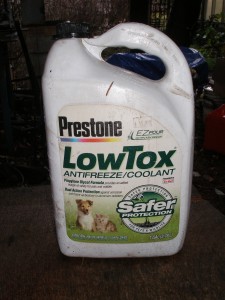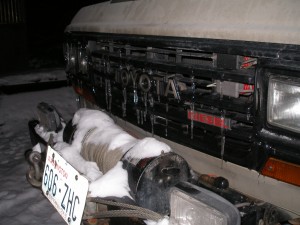By Tony K
 If like me you thought the differences between antifreeze was simply a choice between green or red you would be mistaken… First of all, color means nothing. The base component of antifreeze is clear. Red, green, blue, purple, orange and pink are all just dyes added to differentiate ones own brand. And sadly there is no industry standard for the color of each type of mix. And I also had no idea how different the mixes really are.
If like me you thought the differences between antifreeze was simply a choice between green or red you would be mistaken… First of all, color means nothing. The base component of antifreeze is clear. Red, green, blue, purple, orange and pink are all just dyes added to differentiate ones own brand. And sadly there is no industry standard for the color of each type of mix. And I also had no idea how different the mixes really are.
This article will not provide all the answers as I found a lot of contradictions, claims and vague information, but hopefully it will help you sort through all the choices for your wagon.
Antifreeze or Coolant?
Whats the difference? Pretty simple actually, coolant is the liquid in your radiator that helps control the heat put out by your engine. Antifreeze is the chemical component that keeps it first from freezing but also contains additives to fight corrosion and scale build up. It also helps prevent boil overs but not to the extent it prevents freezing. Antifreeze is only a component of a coolant mixture.
What Water to Use?
Not until you mix it with the appropriate amount of water does antifreeze become coolant. And what water you use is important. Don’t go to the tap on the house. Tap water has too many minerals and other junk in it that is good for you but not your cooling system. Some areas are worse than others. Such as the really high iron content in my water. Even the high levels of oxygen in it is bad for the system. It’s best to use distilled water or you could just avoid the problem altogether by using the premixed stuff on the shelf as it already has the distilled water in it.
Just What is Antifreeze?
Primarily it is made up of a base material and additives. Essentially there are two main choices when it comes to the base material of antifreeze. Ethylene Glycol (EG) is more common and cheaper than Propylene Glycol (PG), but Propylene is less toxic. But this doesn’t mean non toxic. The additives added to it are also toxic so Low Tox or “less toxic” on the label only applies to the base material. Once antifreeze has served its useful life in your cooling system, it has picked up additional toxins so the mix should always be collected and disposed of safely and responsibly.
While EG and PG in themselves have the thermal properties necessary to be used in the cooling system there are additional considerations. There are a lot of dissimilar metals (copper, brass, cast iron, aluminum, solder, etc) the need to lubricate the water pump in some systems and there is also the need to fight rust, corrosion and scale build up in the cooling system. And this is accomplished with additive packages. Figuring out just what these are and what each component does is not the easiest as most of this info is proprietary to the makers and if used below certain levels it is not even listed on the MSDS sheet.
Traditionally this was phosphates, borates, silicates and some others that I can’t remember. This type of antifreeze is known as Inorganic Acid Technology (IAT). These are what is best described as traditional “green” antifreeze mixes used almost exclusively since the 30’s to cool our engines.
But in the 90’s with all the new technology and new materials, an Organic Acid Technology (OAT) was developed. Probably the most common mix for newer cars on the road today. This blend is really good for the high amounts of aluminum in the newer cars. This type of antifreeze uses none of the old additives. It uses organic acid inhibitors to form a barrier on metal parts to fight corrosion and scale buildup in the coolant system. This new additive package does pretty much the same things but the additives have the additional advantage of being much longer lived. They don’t break down as fast as the old stuff so they have a longer service life, hence the Extended Life Coolant moniker you will find on the label. I also found out that some OAT based coolants supposedly use a Propylene base due to it’s friendlier environmental footprint.
Last on the list is Hybrid Organic Acid Technology (HOAT). These are pretty much the same as OAT mixes but with additional additives for specific reasons. Even bringing back small amounts of the old additives in some formulas. Very popular with the car makers in Europe.
Diesel Specific Mixes
Versions for some diesel engines also have nitrites to combat cavitation erosion. You might be tempted to use them in an old Toyota Diesel, but don’t. Cavitation erosion is an issue with wet sleeve diesels, where the cylinder sleeve is in contact with the coolant. Toyota diesels like the 3B are a dry sleeve motor so they don’t need nitrites. Another point to consider is that too much nitrate will react poorly with the solder of our radiators and heater cores. Using a diesel specific mix just may cause an issue with your radiator.
I also found newer mixes are available that contain none of the old additives that were originally in diesel specific antifreeze. Can these be safely used in our old dry sleeve diesels? Is there any benefit to them? I am still looking for answers to these.
When in doubt, trust Toyota. The components inside your engine need a coolant mix that will protect it the best. And the best place to find out just what you need is your owners manual. The manual for my BJ60 states to use only an ethylene glycol mix, but I have a dog so I cheat a bit and use a propylene mix just in case I spill some when working on my rig.
As for older rigs such as our wagons, I would only use an IAT type of mix, commonly called green antifreeze. Yes it takes the most frequent maintenance but this formula is the best to use with our brass and copper radiators as the additives are less likely to have issues with the solder that holds them together.
OAT and HOAT mixes may not be the best choice for older rigs as there are some compatibility issues between the organic inhibitors they contain and the solder that holds our brass and copper radiators together. But I have found one site that said they may be OK as long as you use the same service guidelines as the older style antifreeze, meaning changed at the old intervals, don’t leave them in the system for extended periods. And down the road these may be the only mixes available as there are fewer and fewer rigs that need the old stuff so less of it is being made today.
Maintenance
Over time and through use all coolant mixtures break down, the additives start to fall out of solution or simply degrade and the coolant is no longer capable of doing its job effectively. Maintaining the proper mix ratio will make them last longer and this can be checked by measuring the specific gravity (sorry to say this method can’t be used with a propylene base antifreeze) or by using a refractometer. The chemical make up can be checked through lab analysis or with test kits but most people including me just change the stuff at the suggested interval, about 2 years or 30,000 miles which ever comes first.
 And don’t hesitate to ask a radiator shop what is best for your rig. These are the guys rebuilding and fixing things for your cooling system on a regular basis. It could be that they have the best ideas for what will work the best for your rig.
And don’t hesitate to ask a radiator shop what is best for your rig. These are the guys rebuilding and fixing things for your cooling system on a regular basis. It could be that they have the best ideas for what will work the best for your rig.
Don’t Mix and Match
While the base of antifreezes is compatible mixing the different types will only render the additive packages ineffective at best and possibly shorten the life of your cooling system at worst. Top off with the same mix that is in your system currently. Which is why I find it somewhat odd that the makers of what are so called universal coolants, meaning good for any system etc, say you can add them to any other type of antifreeze. But should the need arise you should only top off with theirs….
In the short term such as an emergency you can use another type of antifreeze but change it out to the proper type as soon as you can. Other option may be to just get by with water….
Whats the Future Hold
One of the interesting facts I found in my research holds some great promise for the future. Until World War I it was not uncommon to find Glycerine being used as a coolant but the need for glycerine in exposives brought out alternatives for cooling. Mainly, Ethylene Glycol. And why is this info beneficial to the future? With the advent of Biodiesel there is now a glut of source material that is friendly to the environment. One of the main byproducts of Biodiesel production is Glycerol, or better known in the past as Glycerine…. Non toxic, non polluting and becoming more available all the time.



